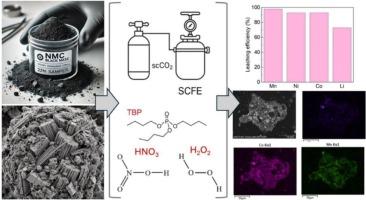Recycling of NMC black mass from spent lithium-ion battery using supercritical fluid extraction
IF 7.1
2区 环境科学与生态学
Q1 ENGINEERING, ENVIRONMENTAL
引用次数: 0
Abstract
The growing demand for lithium-ion battery recycling has intensified interest in selective and sustainable metal recovery techniques. In this study, we apply supercritical fluid extraction (SCFE) to real industrial black mass, containing mixed-metal oxides along with typical impurities such as conductive carbon, binder residues, and metallic fragments. Unlike previous SCFE research focused on pure cathode powders, this work demonstrates the feasibility and selectivity of the process under practical impurity conditions. Using supercritical CO2 in combination with a tributyl phosphate–nitric acid adduct and hydrogen peroxide as a reducing agent, the process was optimized via full factorial design and response surface methodology. Under optimal conditions (65 °C, 20.7 MPa, 5 mL/g adduct-to-solid ratio in units of mL adduct per gram of black mass, 8 mL (per 8 g of feed) hydrogen peroxide), extraction efficiencies exceeded 90 % for Ni, Co, and Mn, while Li recovery reached 73 %. Characterization by XRD, SEM-EDX, Raman spectroscopy, and TC/TOC analysis confirmed metal removal and the structural persistence of carbonaceous material in the residue. Parametric tests highlighted the critical roles of the adduct and reducing agent in enabling efficient complexation and solubilization of transition metals. This work demonstrates that SCFE is a promising low-impact, chemically selective approach for lithium-ion battery recycling, capable of operating under mild conditions with reduced reagent consumption. It advances the feasibility of scalable, environmentally responsible recovery of critical materials from post-consumer batteries and sets the foundation for future integration with downstream purification or hybrid recycling technologies.

超临界流体萃取法回收废锂离子电池NMC黑质量
锂离子电池回收需求的不断增长,增强了人们对选择性和可持续金属回收技术的兴趣。在本研究中,我们将超临界流体萃取(SCFE)应用于实际的工业黑色物质,其中含有混合金属氧化物以及典型杂质,如导电碳,粘合剂残留物和金属碎片。不同于以往的SCFE研究集中在纯阴极粉末上,这项工作证明了该工艺在实际杂质条件下的可行性和选择性。以超临界CO2、磷酸三丁酯-硝酸加合物和过氧化氢为还原剂,通过全因子设计和响应面法对工艺进行优化。在最佳条件下(65℃,20.7 MPa, 5 mL/g加合物-固比(单位为mL/g黑色质量),8 mL(每8 g饲料)过氧化氢),Ni, Co和Mn的萃取效率超过90%,Li的回收率达到73%。通过XRD、SEM-EDX、拉曼光谱和TC/TOC分析,证实了残渣中金属的去除和碳质物质的结构持久性。参数测试强调了加合物和还原剂在实现过渡金属的有效络合和增溶方面的关键作用。这项工作表明,SCFE是一种有前途的低影响、化学选择性的锂离子电池回收方法,能够在温和的条件下运行,减少试剂消耗。它提高了从消费后电池中可扩展、环保地回收关键材料的可行性,并为未来与下游净化或混合回收技术的整合奠定了基础。
本文章由计算机程序翻译,如有差异,请以英文原文为准。
求助全文
约1分钟内获得全文
求助全文
来源期刊

Waste management
环境科学-工程:环境
CiteScore
15.60
自引率
6.20%
发文量
492
审稿时长
39 days
期刊介绍:
Waste Management is devoted to the presentation and discussion of information on solid wastes,it covers the entire lifecycle of solid. wastes.
Scope:
Addresses solid wastes in both industrialized and economically developing countries
Covers various types of solid wastes, including:
Municipal (e.g., residential, institutional, commercial, light industrial)
Agricultural
Special (e.g., C and D, healthcare, household hazardous wastes, sewage sludge)
 求助内容:
求助内容: 应助结果提醒方式:
应助结果提醒方式:


